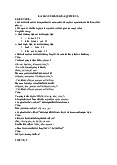











Preview text:
lOMoAR cPSD| 36006831
MINISTRY OF EDUCATION AND TRAINING ----o0o----
HO CHI MINH CITY UNIVERSITY OF FOREIGN LANGUAGES
AND INFORMATION TECHNOLOGY – (HUFLIT) TERMPAPER
APPLY TECHNOLOGY TO ENHANCE LEARNING ENGLISH LANGUAGE FOR UNIVERSITY STUDENTS
Instructor: Ms. Tran Thi Truc Duyen (M.A)
Student: Nguyen Thi Kim Anh
Student’s ID number: 21DH716355 Class: TA2108
HO CHI MINH CITY, November , 2023 lOMoAR cPSD| 36006831 NAME: NGUYEN THI KIM ANH STUDENT ID: 21DH716355 UNIT NAME: Term Paper
EMAIL ADDRESS: 21dh716355@st.huflit.edu.vn
DATE SUBMITTED: 25 November 2023 WORD COUNT: 2139 word Declaration
I certify that the attached material is my original work. No other person’s work or ideas
have been used without acknowledgement. Except where I have clearly stated that I
have used some of this material elsewhere, I have not presented this for assessment in
another course or unit at this or any other institution. Name/signature Nguyen Thi Kim Anh Date:
INSTRUCTOR’S ASSESSMENT Abstract Introduction Body Conclusion References lOMoAR cPSD| 36006831 TABLE OF CONTENTS
I. INTRODUCTION ............................................................................................................... 1
II. BODY .................................................................................................................................. 1
2.1 Technology as an Integral Part of Education ................................................................... 1
2.1.1 Enhancing Learning Through Technology ................................................................ 1
2.1.2 Innovative Teaching Methods ................................................................................... 2
2.1.3 Challenges and Considerations .................................................................................. 2
2.2. Technology in Reading Comprehension ......................................................................... 2
2.3. Technology in Assessments and Learning Support ......................................................... 3
2.4. Technology in Language Learning Classes ..................................................................... 3
2.4.1. The importance of Technology in English Language Classes .................................. 4
2.4.2. Effectiveness of Machine Translation in Language Education ................................ 4
2.4.3. Learning Vocabulary and Pronunciation through Technology ................................. 4
III. CONCLUSION ................................................................................................................. 6 ABSTRACT
This term paper explores the application of technology to enhance the learning of the
English language for university students. The background information highlights the
increasing importance of English proficiency in higher education and the evolving role of
technology in modern education. The paper delves into the benefits of technology as an
integral part of education, focusing on its s contributions to learning vocabulary and
pronunciation and enhance the ability of Reading Comprehension. Additionally, it evaluates
the effectiveness of machine translation in language education. The reasons for incorporating
technology into education, specifically in assessments and learning support. It examines the
influence of technology in English language classes, emphasizing its significance.
Emphasizing the trans-formative potential of technology, the study underscores the
significance of its thoughtful incorporation to foster effective language acquisition and academic success
Keyword: technology, language, English Nguyen Thi Kim Anh lOMoAR cPSD| 36006831 I. INTRODUCTION
In today's globalized world, proficiency in the English language is a critical skill for university
students. It opens doors to diverse opportunities in education, career, and communication. The
traditional methods of learning English are being reshaped by the integration of technology in
education. This paper explores the contemporary landscape of English language learning in
universities, focusing on the role of technology in facilitating this process.
The background information delves into various perspectives regarding the incorporation of
technology in second-language education. Mike Levy highlights the importance of grasping
the achievements of technology and cautions against the possible overwhelm that learners and
teachers could experience due to the expanding array of technological options (Levy, December
2009). In their discussion from October 2011, Suresh Kumar and P.Sreehari explore the role of
Computer-Assisted Language Learning (CALL), emphasizing the costeffectiveness of
computer systems in an educational setting and acknowledging the significance of computer
labs in facilitating teaching and learning. Additionally, Chun (2006) expands on the topic of
CALL technologies specifically in the context of second language (L2) reading, incorporating
electronic dictionaries, annotated software, and web-based activities.
This term paper aims to delve into the trans-formative potential of technology in the realm of
English language education for university student. By examining the diverse array of
technological tools and methodologies available, it seeks to illustrate how technology can be
leveraged to learn English in the best way. The central theme of this paper revolves around
advocating for integration of technology as a catalyst for enhancing English language acquisition II. BODY
2.1 Technology as an Integral Part of Education
For quite some time, education has been as a crucial pillar for both societal advancement
and personal development. In recent times, technology has emerged as vital component in
educational systems, fundamentally changing how knowledge is both shared and received.
Technology presence is now vital in contemporary education, enhancing the learning process
and reshaping how teachers approach their methods. Its incorporation has made education more
democratic, personalized the learning journey, and promoted collaborative efforts.
2.1.1 Enhancing Learning Through Technology
The incorporation of technology in education has significantly revolutionized learning.
Interactive tools, multimedia resources, and online platforms have revolutionized the
traditional classroom into an engaging environment. The available materials such as visual
tools and interactive simulation, cater to various learning preferences while also encouraging
active engagement and fostering analytical thinking. For instance, virtual labs provide a riskfree Nguyen Thi Kim Anh 1 lOMoAR cPSD| 36006831
and cost-effective way for students to explore scientific concepts, fostering a deeper
understanding and practical application of theoretical knowledge
2.1.2 Innovative Teaching Methods
The incorporation of technology has fundamentally transformed the methods of instruction,
empowering educators to create dynamic, captivating, and personalized learning experience.
The conventional teaching model, where the educator is the central source of information, is
progressively evolving into an approach where educators guide learning rather than simply
imparting knowledge. This change is made feasible by adaptive learning platforms that assess
students’ strengths and weaknesses, enabling teachers to adjust their methods and offer targeted support.
2.1.3 Challenges and Considerations
While the advantages of integrating technology into education are plentiful, there are still
persistent challenges that need to be addressed. Educational inequality is exacerbated by
disparities in access to technology, encompassing discrepancies in both device availability and
internet connectivity. Furthermore, the rapid evolution of technological advancement requires
continuous teacher training to ensure educators are equipped with the necessary skills to
effectively incorporate these tools into their teaching practices.
2.2. Technology in Reading Comprehension
In the quest to enhance reading comprehension abilities in the era of digital technology, a
pioneering web-based reading prototype has been created with the aim of boosting reading
success. For example, Dalton, Proctor, Uccelli, Mo, and Snow (2011) created a web-based
reading prototype aimed at enhancing reading proficiency. The primary objective of the
scaffolding mechanism is to guide students through the process of reading digital texts by
incorporating prompts within the content, prompting them to employ specific reading
strategies. The main focus of this prototype is to utilize scaffolding techniques, aiming to lead
students incorporating prompts that encourage the application of essential reading strategies.
Utilizing TELL Platforms to Support Reading Strategies. Within the domain of Technology-
Enhanced Language Learning, the design of platforms and programming of software
seamlessly facilitate the support the structure of reading strategies. Tailored to the needs of
young learners, TELL platform are strategically crafted to guide them through texts with
precision. Within the digital interface, interactive glossaries. Pronunciation guides, and
comprehension quizzes are seamlessly woven in, delivering immediate real-time support.
Carefully crafted, these support structures are designed with precision to enhance vocabulary
acquisition, refine pronunciation skills, and strengthen overall comprehension. The primary
objective is to not only make the reading process more accessible but also to create a more
enjoyable experience for young learners, guaranteeing a rich and engaging educational journey. lOMoAR cPSD| 36006831
In the domain of Technology-Enhanced Language Learning (TELL) , reading surpasses the
typical, passive deciphering of written text. Instead, it evolves into a dynamic process
facilitated by technology. Features like clickable words offering definitions, audio
pronunciation assistance, and integrated comprehension questions convert reading into an
interactive experience. Learners are prompted to actively engage with the content, solidifying
their understanding through hands-on participation.
2.3. Technology in Assessments and Learning Support
The introduction of Adaptive Learning Technology for Languages marks a fundamental
change in language education. Through the combination of personalized learning paths, data
analysis, and speech recognition, it generates a language acquisition journey that is not only
more efficient and captivating but also customized to each learner’s needs. The profound
impact of personalized learning paths on motivation and achievement cannot be overstated. By
aligning educational content with a student’s current proficiency, there is a greater chance for
learners to experience success, fostering both a sense of accomplishment and motivation. The
adaptive nature of the system effectively addresses the unique needs of each student, creating
a positive feedback loop that significantly enhances their overall accomplishment in language learning.
Examines the groundbreaking influence of including multimedia materials, interactive
reading aids, and collaborative writing platforms in the realm of language education. It explores
the function and benefits of each strategy in enhancing listening, reading, writing, and speaking
abilities The multimedia approach enhances listening proficiency through realworld context,
utilizing audio clips, podcasts, and videos. Interactive reading tools redefine reading
experience, fostering comprehension through features like annotations and multimedia support.
Platforms for writing collaboratively, exemplified by online tools like Google Docs, initiate a
trans-formative improvement in refining writing abilities by incorporating elements such as
real-time collaboration, peer review, and automated feedback. The conclusion highlights the
essential contribution of these approaches in establishing a vibrant and interactive language
learning environment, enabling students to adeptly navigate the diverse realm of languages.
2.4. Technology in Language Learning Classes
In language learning classrooms, technology has brought about a significant revolution. The
introduction of creative tools and methods has transformed the overall educational experience.
The infusion of technology has introduced inventive methods for language learning. Creative
tools have become pivotal in augmenting the efficacy of conventional educational approaches.
The infusion of technology into language learning has elevated the educational experience,
providing students with a multitude of tools that enhance both engagement and effectiveness in the learning process. Nguyen Thi Kim Anh 3 lOMoAR cPSD| 36006831
2.4.1. The importance of Technology in English Language Classes
The impact of technology in English language classes is substantial, providing transformative
advantages that enrich both teaching and learning experiences significantly. Technology
facilitates exposure to authentic language use through online resources, social media, and real-
life communication scenarios. It provides diverse and interactive materials, catering to various
learning styles and keeping students actively involved in the learning process. Personalized
feedback and progress tracking contribute to a more customized and effective learning
experience. Student can engage in real-time conversations with native speakers,fostering
language fluency and cultural understanding. In essence, the integration of technology in
English language classes not only modernizes the teaching approach but also empowers
students with diverse tools and resources that contribute to a more effective, engaging, and
personalized language learning experience.
2.4.2. Effectiveness of Machine Translation in Language Education
Sangmin-Michelle Lee has previously emphasized the increasing use of machine translation
(MT) among students for academic purposes. This trend demands attention from language
teachers and cannot be ignored in their classrooms any longer
Machine translation (MT) has become a significant element in language education, reshaping
conventional methods of language learning and communication. The inclusion of machine
translation (MT) in language education programs raises questions about its effectiveness and
impact on language acquisition. This investigation thoroughly examines the diverse aspects of
machine translation in the realm of language education.
The progress of machine translation has been a dynamic process characterized by
technological advancements and growing sophistication. As these MT tools have developed,
they have seamlessly become part of language education practices. This integration encourages
a thoughtful examination of how machine translation complements and challenges traditional
teaching methods. While it opens up new opportunities for language learners, it also requires a
reassessment of conventional approaches to fully leverage the immense potential of this
groundbreaking technology. The interplay between the evolution of machine translation and its
integration into language education is a multifaceted and everchanging interaction that shapes
the landscape of language learning in today’s world.
2.4.3. Learning Vocabulary and Pronunciation through Technology
A study by Henriette L. Arndt published on January 10, 2018, investigates vocabulary
learning through YouTube videos and blog posts, offering a unique perspective on the potential
of digital media in language acquisition. The introduction summarizes key findings and
implications, suggesting insights that could benefit both educators and learners in the field of
language learning (Arndt, 2018).Encouraging the acquisition of vocabulary incidentally via
Netflix series proves to be a dynamic and efficient strategy for language learning. Through the lOMoAR cPSD| 36006831
use of glossed captions, readily accessible on streaming service like Netflix, learners can
instantly obtain definitions for unfamiliar words with a simple click.This functionality
empowers users to pause and revisit these words within the context of the series, reinforcing
comprehension. Moreover, the incorporation of language learning extensions, such as browser
tools providing instant translation and definitions, enriches the overall learning journey. This
enables viewers to quickly grasp the meanings of words, fostering a smooth and immersive language-learning experience
Exploring pronunciation skills via television series represent a forward-thinking method that
surpasses conventional language learning approaches. The “Repeat and Imitate” strategy
encourages learners to interact dynamically with the content by revisiting scenes featuring
native speaker. Through imitation of pronunciation and intonation, learners can assimilate the
subtleties of the language, concentrating on the cadence and melody of speech to improve
overall fluency. Additionally, integrating phonetic exercises into language learning apps or
online platforms enables learners to focus on particular sounds prevalent in the target language.
This approach fosters a more thorough grasp of the intricacies of pronunciation.
Effective motivation is vital in computer-assisted pronunciation training, regardless of the
learning environment. The incorporation of gamified elements, such as rewards and
competitions, enhances engagement. Empowering learners to set and celebrate achievable
goals is facilitated through progress tracking. Technology-driven personalized learning plans
concentrate on individual strengths and weaknesses. Real-time interactive feedback serves to
correct errors and strengthen correct articulation. Features promoting social connectivity
establish a community feel, allowing learners to exchange achievements and tips. The
utilization of Virtual Reality (VR) technology provides immersive language learning
experiences, especially in pronunciation training, by presenting realistic scenarios in various contexts. Nguyen Thi Kim Anh 5 lOMoAR cPSD| 36006831 III. CONCLUSION
This term paper explores the trans-formative possibilities of technology in university-level
English language education. It investigates various technological tools and methodologies to
demonstrate how they can optimize the learning of English. The paper advocates for the
integration of technology as a catalyst to enhance the acquisition of the English language. The
primary focus of this section is to examine the diverse roles of technology in education. It
explores its integration into education as a whole, its specific applications in reading
comprehension and assessments, and learning support. The section also delves into the
significance of technology in language learning classes, emphasizing its importance, the
effectiveness of machine translation, and its role in learning vocabulary and pronunciation.
Additionally, it discusses how technology facilitates improved access to educational resources. lOMoAR cPSD| 36006831 REFERENCES
Muzakki Bashori, Roeland van Hout, Helmer Strik & Catia Cucchiarini (2022) Computer
Assisted Language Learning, 1, DOI: 10.1080/09588221.2022.2080230
Sangmin-Michelle Lee ( 22 Apr 2021 ). Computer Assisted Language Learning, 103-125.
DOI: 10.1080/09588221.2021.1901745
Conor Flynn ( 12 January, 2018). How Adaptive Learning Technology Supports Languages.
Isabeau Fievez, Maribel Motero Perez, Frederik Cornilie & Piet Desmet (28 May 2021).
Computer Assisted Language Learning, 26-51. DOI:
10.1080/090588221.2021.1899244
Scheffler, Paweł; Baranowska, Karolina ( 10 July 2023). Language Learning &
Technology. https://www.lltjournal.org/item/10125-73520/
Emma Cullen ( 27 March 2023 ). What is Technology Enhanced Learning ?. Mentimeter.
Mohammad Reza Ahmadi ( 20 June 2018). The Use of Technology in English Language
Learning. International Journal of Research in English Education 3(2):115-125. DOI: 10.29252/ijree.3.2.115
Yalun Zhou, Michael ( 2018 ). Strategies in technology-enhanced language learning.
Studies in Second Language Learning and Teaching 8 ,471-495
https://files.eric.ed.gov/fulltext/EJ1183997.pdf
Vawn Himmelsbach (11 May 2022). How Education Technology in the Classroom
Can Impact Student Learning. Education Technology
Kevin C. Costley, Ph.D (30 October 30 2014) The Positive Effects of Technology on
Teaching and Student Learning
Mike (December 2009) Technologies in Use for Second Language Learning. Modern
Language Journal 93(s1): 769-782. DOI: 10.1111/j.1540-4781.2009.00972.x
E. Suresh Kumar, P.Sreehari (Octorber 2011) Computer Assisted Language Learning (CALL)
A Handbook for English Language Laboratories, 3-14. DOI: 10.1017/UPO9788175968677.003
N. Garrett ( December 2009) The Modern Language Journal. Volume 93, Issue s1. 719-740.
DOI: 10.1111/j.1540-4781.2009.00972.x Nguyen Thi Kim Anh lOMoAR cPSD| 36006831
M. Salaberry ( March 2001) The Use of Technology for Second Language Learning and
Teaching. Modern Language Journal 85(1) 39-56. DOI: 10.1111/0026-7902.00096
Arndt, H. L., Woore. R. (October 2018) Vocabulary Learning from watching YouTube videos
and reading blog posts. Language Learning & Technology, 22(1), 124-142. https://doi.org/10125/44660 NguyenThiKim An h



